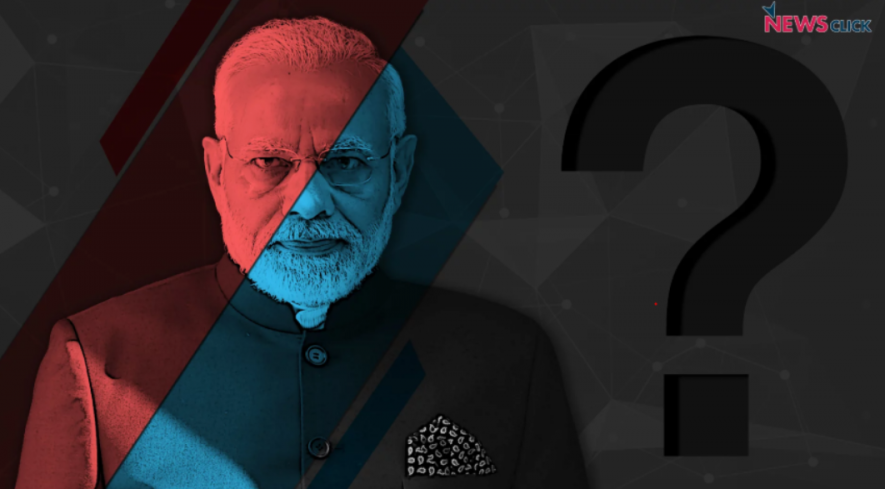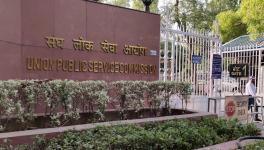Callous, Incompetent: The Modi Regime’s Report Card

Two things plague India today: The Bharatiya Janata Party (BJP) and the parivar it is embedded in; and the governments, especially the one at the Centre, the party runs. The party and the parivar are obscurantist, sectarian and anti-democratic; and the governments the BJP runs are characterised by incompetence and chest-thumping.
Between them, they have served up a menu of incompetents that have sunk the economy, exacerbated the effects of the COVID-19 pandemic with their mismanagement and pushed the nation into an abyss of sectarianism not witnessed since the aftermath of the Partition.
Let’s focus on the incompetence, since Prime Minister Narendra Modi came to power in 2014 promising development and small government but effective governance, free of corruption.
Let us approach the current regime’s handling of the pandemic, as an extreme case of incompetence, callousness and self-aggrandisement, after a small detour. On April 20, the Government of India’s chief economic advisor (CEA), Krishnamurthy Subramanian, said India was perhaps the only country with a large economy to use the crisis caused by the pandemic to change its economic thinking.
“The country has worked to convert this challenge into an opportunity with the concept of Atmanirbhar Bharat,” he is reported as having said. He also said that the impact of the pandemic should not be ‘very large’ in the long run, though he conceded he was concerned about the ‘loss of production capacity’.
Three things stand out in Subramanian’s statement: self-congratulation, percolating down from Modi himself; vacuity; and extreme insensitivity. Let’s take the first two together. It is not clear how Subramanian arrived at his assessment and what exactly he means by ‘very large’. He estimates, with the most becoming disclaimer of not being an epidemiologist, the pandemic will peak in mid-May. On the basis of what? We’d been hearing of green shoots and V-shaped recoveries for a while, until the government was caught on the hop when a second wave began roaring through the country. We’re not getting statistical here, because both from the public health and economic perspectives, the carnage is evident.
But what do we make of the statement suggesting that India is perhaps the only country with a large economy that has changed its thinking. First, how exactly is the idea of atmanirbhar or ‘self-reliant’ new? It was a fundamental economic mantra for four decades or so until the liberalisation shtick came into town in the 1990s. The only change, one presumes, is that self-reliance will now be delivered by the domestic private sector bolstered by foreign capital.
Second, are we all supposed to be impaired in every possible sensory department? Or, is it just that our CEA has failed to notice that economic orthodoxies are being overturned all over the world? Nowhere, more so than in the US, the bastion of the free-market, trillions of dollars are being spent to alleviate immediate distress, with little concern for fiscal prudence.
Last time, we heard there was a distinct possibility that the current US administration was on course to implement a $2-trillion plan to upgrade physical infrastructure, and research and development; implement green projects; and, in the process, provide jobs. It has also been suggested that new corporate and wealth taxes will fund these. Sounds like a major re-orientation in economic thinking, doesn’t it?
And then there has been a resurfacing of conversations about a minimum global corporate tax, backed strongly by the US and OECD countries, to address the problem of massive tax avoidance through tax havens. This might not have a big impact on emerging and developing countries, but there can be no doubt that it would be a fundamental shift.
Then again, all this might come to nothing. Come to think of it, given the Modi regime’s stellar track record in economic management, the same thing can probably be said about ‘Atmanirbhar Bharat’, which, translated into English, also means ‘hot air’.
Let’s forget the detour and get to the insensitivity bit that personifies the Modi regime. To begin with, the day Subramanian was holding forth about using adversity as an advantage, new COVID-19 infections had clocked in at 224,000, the second highest number for a single day ever, globally. The next day, it was reported that over 3.4 million cases had been reported in the month (till the evening of April 24), of which half – 1.7 million – had been reported in the preceding week, the highest count globally, ever. India had also recorded its highest COVID-19 death toll at 2,624.
April has been the cruellest month. May threatens to be worse. To talk about converting a challenge into an opportunity at this juncture is beyond comprehension. It is unforgivable on other counts as well, especially the failure to provide essential medical supplies and infrastructure. Particularly reprehensible has been the Centre’s inability to provide vaccine doses or medical oxygen supplies in adequate quantities, the latter directly causing the death of a large number of people.
It was reported on April 23, that a member of the national task force on COVID-19 had admitted off the record that the government ignored national and global data suggesting a ‘big wave’ was possible and that the current crisis has been caused by complacency.
True to form, however, the Modi regime is now trying to slime its way out by passing the buck to the states. But it can’t, because it centralised powers in its hands in March last year by invoking the Disaster Management Act, 2005, in another first ever, but couldn’t deliver.
Though everyone knows about the oxygen situation now, the government’s ineptitude in this regard must be iterated. It took the regime eight months to start the tender process for setting up new facilities to generate medical oxygen. Over a year has passed, but only 33 out of 162 planned facilities are up and running. The Union Health Ministry says that by the end of May, 80 plants will be installed, whatever that means. More than 14 months will have passed by then since the imposition of last year’s lockdown (on March 25).
The same is true of the vaccination programme. While Modi has engaged in ‘vaccine diplomacy’, which would have been unexceptionable had his regime made arrangements for adequate domestic supplies, the queues have been getting longer at home. Many are having to go home without getting a shot. The pricing issue has gone out of control and now not only is the Centre trying to pass the buck to states, following its policy of uncooperative federalism, the Supreme Leader is also trying hard to sell the idea that it’s all the fault of a recalcitrant population.
Thus, while the geniuses in the corridors of Lutyens’s Delhi are busy forging new directions in economic management and modelling, people are gasping for life, without ventilators, without oxygen. Life-saving drugs are also in short supply, as, too, are COVID-19 tests.
As the health system is getting overwhelmed and collapsing, people with other serious illnesses are also feeling the aftershocks. We don’t know how many people are dying for want of treatment for these because we are not counting the ‘excess deaths’.
The writer is an independent journalist and researcher. The views are personal.
Get the latest reports & analysis with people's perspective on Protests, movements & deep analytical videos, discussions of the current affairs in your Telegram app. Subscribe to NewsClick's Telegram channel & get Real-Time updates on stories, as they get published on our website.
























